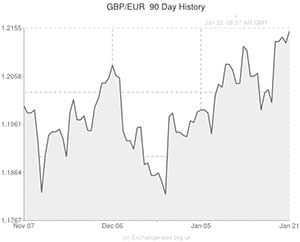
In the week’s first major shift among European currencies the Euro has plummeted to a one-year low against its British counterpart as a result of unexpectedly strong UK employment data.
A lack of influential news for the Eurozone restrained Euro movement early into local trading, but the common currency went on to shed 0.5 per cent against the Pound and weaken to its lowest level since January 2013.
The Pound surged against the majority of its currency counterparts as the UK’s unemployment rate surprised expectations and fell to 7.1 per cent in the three months through November, dropping from 7.4 per cent and smashing forecasts for a reading of 7.3 per cent.
The steep drop in UK joblessness stands in sharp contrast to the record high levels of unemployment recorded in the Eurozone.
Sterling was already riding high thanks to last week’s better-than-anticipated UK retail sales figures and yesterday’s slightly disappointing ZEW economic sentiment survey helped the Pound consolidate gains against the Euro before it was buoyed by today’s news.
However, as the Bank of England set a 7 per cent unemployment rate as the target for beginning to increase interest rates from record lows the minutes from the central bank’s latest policy meeting were of particular interest today and prevented the Pound heading even higher.
In the minutes the Monetary Policy Committee stated; ‘Members therefore saw no immediate need to raise Bank Rate even if the 7 per cent unemployment threshold were to be reached in the near future. Moreover, it was likely that the headwinds to growth… would persist for some time yet, and that inflationary pressures would remain contained. Consequently when the time did come to raise Bank Rate, it would be appropriate to do so only gradually.’
EUR/GBP losses were also slightly limited by the news that the debts of Eurozone governments slipped in the three months to September in the first decline since the global economic crisis began at the end of 2007.
According to the European Union’s statistics agency, the combined debts of the Eurozone member nations fell from 93.4 per cent of GDP in the second quarter to 92.7 per cent in the third.
Whilst this is still massively above the 60 per cent of GDP limit set by EU rules, the result is still an indication that the Eurozone’s economic recovery continues to move in the right direction.
Tomorrow EUR/GBP volatility is likely to persist as manufacturing/services reports for Germany and the Eurozone are published.
The figures are forecast to show improvement and could help the Euro recover today’s losses.
Euro Exchange Rates
[table width=”100%” colwidth=”50|50|50|50|50″ colalign=”left|left|left|left|left”]
Currency, ,Currency,Rate ,
Euro, ,Pound Sterling,0.8186,
,Pound Sterling,0.8186,
Euro, ,US Dollar,1.3538 ,
,US Dollar,1.3538 ,
Euro, ,Canadian Dollar,1.4850,
,Canadian Dollar,1.4850,
Euro, ,Australian Dollar,1.5271 ,
,Australian Dollar,1.5271 ,
Euro, ,New Zealand Dollar,1.6263 ,
,New Zealand Dollar,1.6263 ,
US Dollar, ,Euro ,0.7384,
,Euro ,0.7384,
Pound Sterling, ,Euro,1.2214,
,Euro,1.2214,
Canadian Dollar, ,Euro,0.6734 ,
,Euro,0.6734 ,
Australian Dollar, ,Euro,0.6552 ,
,Euro,0.6552 ,
New Zealand Dollar, ,Euro,0.6146 ,
,Euro,0.6146 ,
[/table]

Comments are closed.